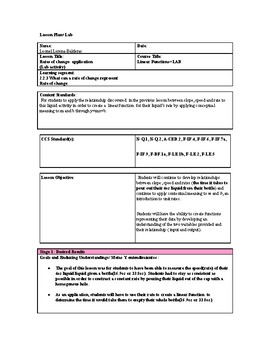Functions and rate of change lesson+LAB activity
- PDF
Description
Educator:
In this lesson educators will be provided a detailed lesson plan including materials for the lab to be performed. This lesson is projected for 100 minutes additionally with an opportunity to challenge students with a detailed lab on rates of change with a time frame of 45 minutes.
The lesson is meant to guide educators throughout the concept of rate of change, linear equations, and data collections as well as data analysis to be able to make relationships and predictions of the data collected throughout the lesson and lab.
The lesson finishes with open questions that promotes an open ended discussion, promotes critical thinking and the recap of the lesson as well as learning objectives and the applications found in the lab.
Student(s):
In this lab students will be able to apply and understand linear questions by collecting data through this short and fun activity. This lab provides different liquids to measured while being poured out of bottles listed on the matierla section. Students have been provided with a template and handout which the educator can improvise as needed.
The purpose of this lab is to allow students to note the relationship between the our outputs, inputs, graphs, data table, and to be able to describe the ratio of each measured quantity.
Students should be given the opportunity to explore as much as learning from instructor while receiving an adequate amount of assistance in order to have them engaged and challenge their critical thinking.
Any questions, clarifications, concerns or even collaborations feel free to reach me at leonellerena@gmail.com
Thank you for supporting.





